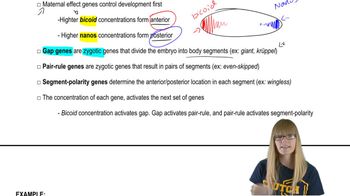Three-spined stickleback fish live in lakes formed when the last ice age ended 10,000 to 15,000 years ago. In lakes where the sticklebacks are prey for larger fish, they develop 35 bony plates along their body as armor. In contrast, sticklebacks in lakes where there are no predators develop only a few or no bony plates. In crosses between fish of the two different morphologies, the lack of bony armor segregates as a recessive trait that maps to the ectodermal dysplasin (Eda) gene. Comparisons between the Eda-coding regions of the armored and nonarmored fish revealed no differences. How can you explain this result?
Table of contents
- 1. Introduction to Genetics51m
- 2. Mendel's Laws of Inheritance3h 37m
- 3. Extensions to Mendelian Inheritance2h 41m
- 4. Genetic Mapping and Linkage2h 28m
- 5. Genetics of Bacteria and Viruses1h 21m
- 6. Chromosomal Variation1h 48m
- 7. DNA and Chromosome Structure56m
- 8. DNA Replication1h 10m
- 9. Mitosis and Meiosis1h 34m
- 10. Transcription1h 0m
- 11. Translation58m
- 12. Gene Regulation in Prokaryotes1h 19m
- 13. Gene Regulation in Eukaryotes44m
- 14. Genetic Control of Development44m
- 15. Genomes and Genomics1h 50m
- 16. Transposable Elements47m
- 17. Mutation, Repair, and Recombination1h 6m
- 18. Molecular Genetic Tools19m
- 19. Cancer Genetics29m
- 20. Quantitative Genetics1h 26m
- 21. Population Genetics50m
- 22. Evolutionary Genetics29m
14. Genetic Control of Development
Developmental Patterning Genes
Problem 24b
Textbook Question
Homeotic genes are thought to regulate each other. Are similar interactions observed between Hox genes?
 Verified step by step guidance
Verified step by step guidance1
Understand the concept of homeotic genes: Homeotic genes are master regulatory genes that control the development of body structures in specific locations. They encode transcription factors that regulate the expression of other genes, ensuring proper body plan formation.
Learn about Hox genes: Hox genes are a subset of homeotic genes found in animals. They are organized in clusters and play a crucial role in determining the identity of body segments along the anterior-posterior axis during embryonic development.
Explore the regulatory interactions between Hox genes: Hox genes often regulate each other through mechanisms such as cross-regulation and feedback loops. This ensures precise spatial and temporal expression patterns necessary for proper development.
Investigate experimental evidence: Studies in model organisms like Drosophila and mice have shown that Hox genes can influence each other's expression. For example, some Hox genes repress or activate neighboring Hox genes within the same cluster.
Conclude the relationship: Similar interactions observed between Hox genes suggest that they work collaboratively to establish the body plan. This regulatory network ensures the correct development of structures in specific regions of the organism.
 Verified video answer for a similar problem:
Verified video answer for a similar problem:This video solution was recommended by our tutors as helpful for the problem above
Video duration:
1mPlay a video:
Was this helpful?
Key Concepts
Here are the essential concepts you must grasp in order to answer the question correctly.
Homeotic Genes
Homeotic genes are a group of regulatory genes that control the development of anatomical structures in various organisms. They play a crucial role in determining the identity of body segments during embryonic development. Mutations in these genes can lead to significant morphological changes, illustrating their importance in developmental biology.
Recommended video:
Guided course

Segmentation Genes
Hox Genes
Hox genes are a specific subset of homeotic genes that are responsible for the anterior-posterior patterning of an organism's body plan. They are highly conserved across species and dictate the formation of structures such as limbs and organs in specific locations. The interactions and expression patterns of Hox genes are critical for proper developmental processes.
Recommended video:
Guided course

Plant HOX genes
Gene Regulation
Gene regulation refers to the mechanisms that control the expression of genes, determining when and how much of a gene product is made. In the context of homeotic and Hox genes, regulatory interactions can influence the expression of these genes, leading to coordinated developmental processes. Understanding these interactions is essential for grasping how complex body plans are established during development.
Recommended video:
Guided course

Review of Regulation
Related Videos
Related Practice
Textbook Question
431
views


